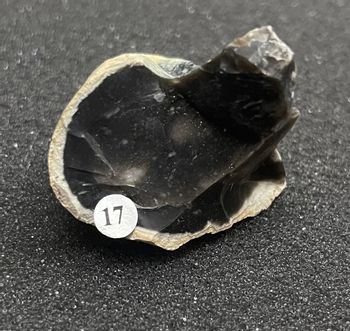Tell me the texture, the grain size, the composition, the rock name and it's deposional environment. The rock I need identify is rock #14 and the image is below. Also there is an example on how it should look on rock #13.
Tell me the texture, the grain size, the composition, the rock name and it's deposional environment. The rock I need identify is rock #14 and the image is below. Also there is an example on how it should look on rock #13.
Applications and Investigations in Earth Science (9th Edition)
9th Edition
ISBN:9780134746241
Author:Edward J. Tarbuck, Frederick K. Lutgens, Dennis G. Tasa
Publisher:Edward J. Tarbuck, Frederick K. Lutgens, Dennis G. Tasa
Chapter1: The Study Of Minerals
Section: Chapter Questions
Problem 1LR
Related questions
Question
Tell me the texture, the grain size, the composition, the rock name and it's deposional environment. The rock I need identify is rock #14 and the image is below. Also there is an example on how it should look on rock #13.

Transcribed Image Text:14

Transcribed Image Text:Sample #
13
Texture
Rough, gritty, coarse
grained
Grain Size
gravel
Composition
Feldspar, hematite,
quartz
Rock Name
Breccia
Depositional
Environment
Mountains
Expert Solution
This question has been solved!
Explore an expertly crafted, step-by-step solution for a thorough understanding of key concepts.
Step by step
Solved in 3 steps

Follow-up Questions
Read through expert solutions to related follow-up questions below.
Follow-up Question
Tell me the texture, the grain size, the composition, the rock name and it's deposional environment. The rock I need identify is rock #17 and the image is below. Also there is an example on how it should look on rock #13.

Transcribed Image Text:**Sample #**: 13
**Texture**: Rough, gritty, coarse-grained
**Grain Size**: Gravel
**Composition**: Feldspar, hematite, quartz
**Rock Name**: Breccia
**Depositional Environment**: Mountains
This table presents information on a rock sample, detailing its features such as texture, grain size, composition, and the depositional environment where it formed. The sample is identified as Breccia, typically found in mountainous regions, with a composition that includes feldspar, hematite, and quartz. The texture is described as rough and gritty, indicating coarse grain size consistent with gravel.

Transcribed Image Text:The image shows a piece of obsidian, a naturally occurring volcanic glass. The surface is smooth and shiny, characteristic of how obsidian is formed when felsic lava cools rapidly with minimal crystal growth. The outer edge displays a lighter, rougher texture, indicating the breakage pattern typical of this material.
On the surface of the obsidian is a small, circular white label with the number "17" printed on it. This label is likely used for identification purposes, possibly corresponding to a catalog entry or for a classroom activity involving rock identification.
The background is dark and textured, providing contrast to highlight the features of the obsidian.
This type of rock is commonly used in educational settings to teach about igneous rocks, volcanic processes, and the physical properties of minerals.
Solution
Recommended textbooks for you

Applications and Investigations in Earth Science …
Earth Science
ISBN:
9780134746241
Author:
Edward J. Tarbuck, Frederick K. Lutgens, Dennis G. Tasa
Publisher:
PEARSON

Exercises for Weather & Climate (9th Edition)
Earth Science
ISBN:
9780134041360
Author:
Greg Carbone
Publisher:
PEARSON

Environmental Science
Earth Science
ISBN:
9781260153125
Author:
William P Cunningham Prof., Mary Ann Cunningham Professor
Publisher:
McGraw-Hill Education

Applications and Investigations in Earth Science …
Earth Science
ISBN:
9780134746241
Author:
Edward J. Tarbuck, Frederick K. Lutgens, Dennis G. Tasa
Publisher:
PEARSON

Exercises for Weather & Climate (9th Edition)
Earth Science
ISBN:
9780134041360
Author:
Greg Carbone
Publisher:
PEARSON

Environmental Science
Earth Science
ISBN:
9781260153125
Author:
William P Cunningham Prof., Mary Ann Cunningham Professor
Publisher:
McGraw-Hill Education

Earth Science (15th Edition)
Earth Science
ISBN:
9780134543536
Author:
Edward J. Tarbuck, Frederick K. Lutgens, Dennis G. Tasa
Publisher:
PEARSON

Environmental Science (MindTap Course List)
Earth Science
ISBN:
9781337569613
Author:
G. Tyler Miller, Scott Spoolman
Publisher:
Cengage Learning

Physical Geology
Earth Science
ISBN:
9781259916823
Author:
Plummer, Charles C., CARLSON, Diane H., Hammersley, Lisa
Publisher:
Mcgraw-hill Education,